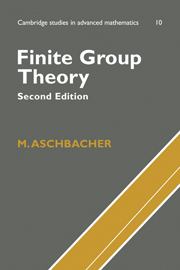Book contents
- Frontmatter
- Contents
- Preface
- 1 Preliminary results
- 2 Permutation representations
- 3 Representations of groups on groups
- 4 Linear representations
- 5 Permutation groups
- 6 Extensions of groups and modules
- 7 Spaces with forms
- 8 p-groups
- 9 Change of field of a linear representation
- 10 Presentations of groups
- 11 The generalized Fitting subgroup
- 12 Linear representations of finite groups
- 13 Transfer and fusion
- 14 The geometry of groups of Lie type
- 15 Signalizer functors
- 16 Finite simple groups
- Appendix
- References
- List of Symbols
- Index
15 - Signalizer functors
Published online by Cambridge University Press: 05 June 2012
- Frontmatter
- Contents
- Preface
- 1 Preliminary results
- 2 Permutation representations
- 3 Representations of groups on groups
- 4 Linear representations
- 5 Permutation groups
- 6 Extensions of groups and modules
- 7 Spaces with forms
- 8 p-groups
- 9 Change of field of a linear representation
- 10 Presentations of groups
- 11 The generalized Fitting subgroup
- 12 Linear representations of finite groups
- 13 Transfer and fusion
- 14 The geometry of groups of Lie type
- 15 Signalizer functors
- 16 Finite simple groups
- Appendix
- References
- List of Symbols
- Index
Summary
Let r be a prime, G a finite group, and A an abelian r-subgroup of G. An A-signalizer functor on G is a map θ from A# into the set of A-invariant r′-subgroups of G such that, for each a, b ∈ A#, θ(a) ≤ CG(a) and θ(a) ∩ CG(b) ≤ θ (b). The signalizer functor θ is said to be complete if there is an A-invariant r′-subgroup θ(G) such that θ(a) = Cθ(G)(a) for each a ∈ A#.
Notice that one way to construct an A-signalizer functor is to select some A-invariant r′-subgroup X of G and define θ(a) = Cx(a) for a ∈ A#. By construction this signalizer functor is complete. If m(A) ≥ 3 it turns out that this is the only way to construct signalizer functors. That is, if m(A) ≥ 3 then every A-signalizer functor is complete. This result is called the Signalizer Functor Theorem. It's one of the fundamental theorems in the classification of the finite simple groups. Unfortunately the proof of the Signalizer Functor Theorem is beyond the scope of this book. However, chapter 15 does contain a proof of a special case: the so-called Solvable 2-Signalizer Functor Theorem. It turns out that the Solvable Signalizer Functor Theorem suffices for many applications of signalizer functors.
An A-signalizer functor θ on G is said to be solvable if θ(a) is solvable for each a ∈ A#. We say θ is solvably complete if θ is complete and θ(G) is solvable.
- Type
- Chapter
- Information
- Finite Group Theory , pp. 229 - 241Publisher: Cambridge University PressPrint publication year: 2000

